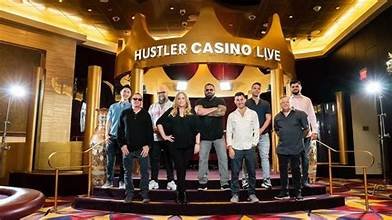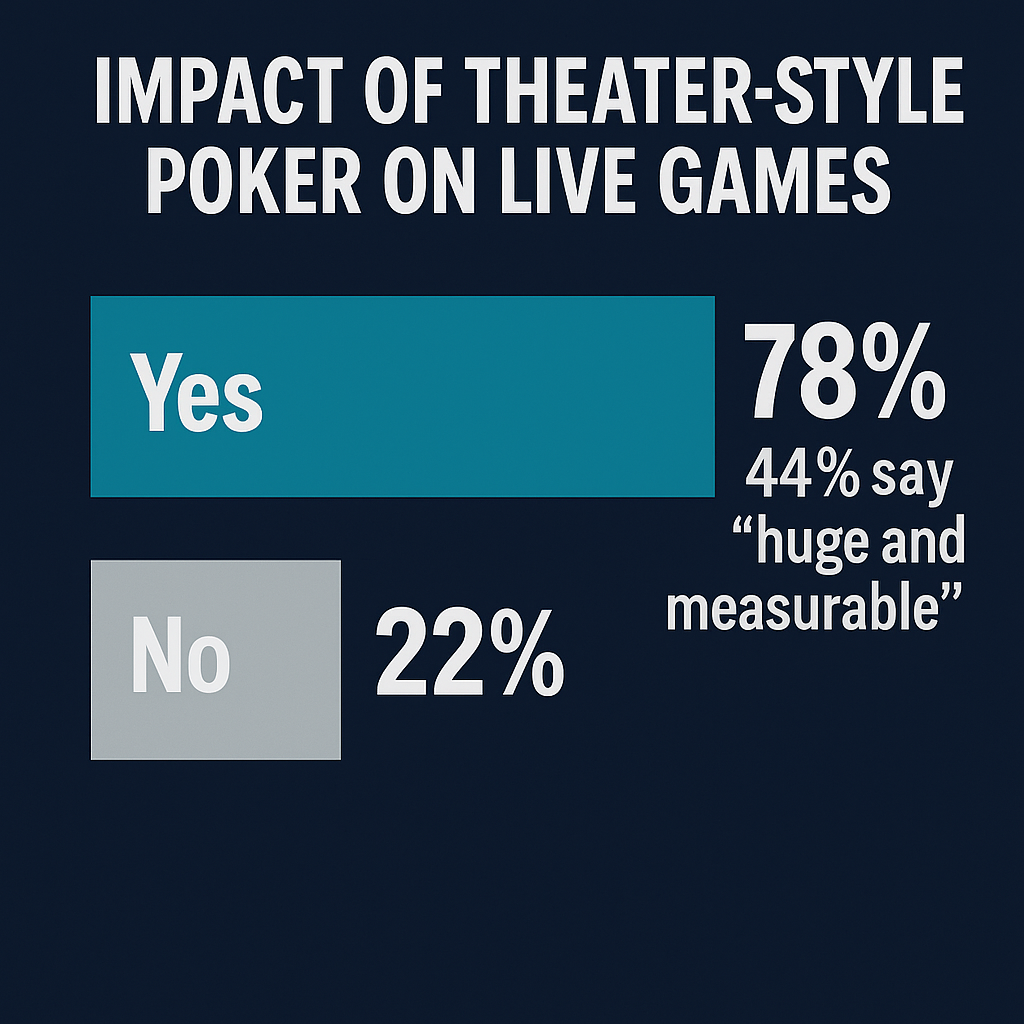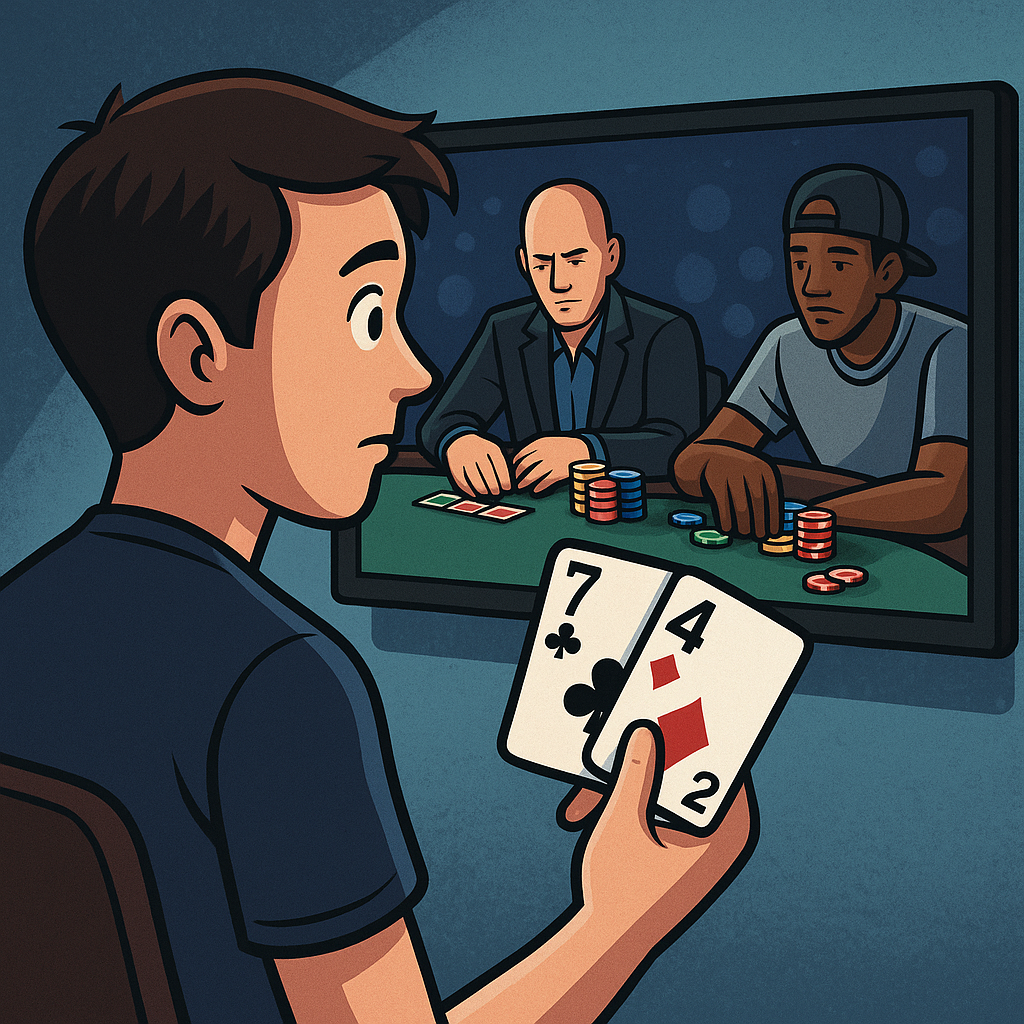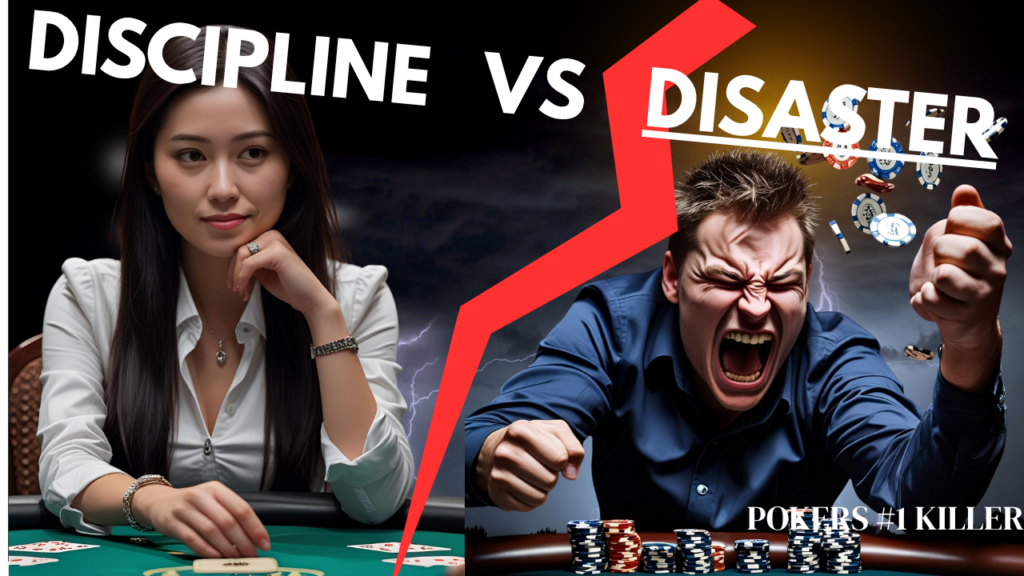THEATER POKER & COPYCAT PLAY
WHY ENTERTAINMENT IS KILLING REAL POKER
Theater poker has risen alongside shows like Poker After Dark, Hustler Casino Live, and the endless highlight reels from the WSOP. These broadcasts are designed first and foremost for entertainment, not education. Big bluffs, junk hands, and dramatic all-ins create suspense, drive clicks, and keep viewers glued to the screen.
But what happens when casual players mistake the show for the game itself? When they see 7♠4♠ drag a huge pot on TV, they don’t see the hundreds of folds and disciplined decisions that never make the cut. They see the drama. They see the exception—and confuse it for the rule.


And sometimes, you have to wonder: was that 7/4 hand a genuine play, or was it selected (or even staged) to maximize the story arc? Either way, the message sent is the same: this is poker.
The result? Copycat play at the local cardroom—players chasing highlight-reel bluffs without understanding the math, context, or psychology that makes them work. Theater poker has blurred the line between drama and strategy, and the game itself has paid the price.
This article takes a hard look at what happens when entertainment collides with strategy — and how theater poker has quietly reshaped the way too many players approach the game.
COMMUNITY INSIGHT-WHAT REAL PLAYERS THINK
It’s not just theory. Real players feel the effects of Theater Poker every time they sit down at the table.
We ran a community poll asking whether Theater Poker has negatively impacted the game. The results were striking: 78% of respondents said yes — with 44% calling the impact “huge and measurable.”
That tells us something important: the frustration is not isolated. When nearly 8 out of 10 players see entertainment poker bleeding into real poker, we can’t dismiss it as “just TV.” It’s shaping how people play at the $1/$3 and $2/$5 tables.

One player put it this way: “If you just copy other players without understanding why they make certain plays, you’ll end up destroying your own game.” (88crazykyle)
Another added: “TV has built interest in poker, but too many players try to emulate the play of the pros — and it doesn’t work against people who aren’t thinking on that level.” (johntrucano8186)
And the examples are everywhere. From beginners trying to replicate a “hero call” they once saw on Poker After Dark, to mid-level grinders firing off junk hands because they “saw it work on a stream,” the spillover is obvious. For many, the damage isn’t just theoretical — it’s personal, showing up in lost pots, longer sessions, and games that feel more chaotic than strategic.
The data makes it clear: Theater Poker isn’t staying on the screen. It’s leaking into the felt.
THE COPYCAT EFFECT: JUNK HANDS GONE WILD

One of the most visible side effects of Theater Poker is what I call the copycat effect. Players see a pro drag a pot with 7-4 offsuit or J-2 suited on a televised cash game and suddenly decide those hands belong in their arsenal.
The logic is simple — and flawed: “If it worked for them, it’ll work for me.”
What gets lost is the context. On a highlight reel, you don’t see the 200 hands that pro folded before taking that shot. You don’t see their image at the table, the stack depths, the bet-sizing patterns, or the fold equity calculations that went into pulling the trigger. You see only the drama — the showdown, the smirk, the pot sliding their way.
That’s the difference between entertainment and education. Poker shows give you the movie trailer: all action, no nuance. Real poker is the book — dense, layered, requiring effort to understand.
And yet, casual players want the shortcut. They’d rather watch the movie than read the book, spoon-fed the illusion that junk hands can win big pots without understanding why. The result? Players walking into $1/$3 games believing Q-3 offsuit is a “creative” weapon — only to find themselves bleeding chips when the math and psychology aren’t in their favor.
Theater poker makes junk hands look like genius. Real poker punishes them.
.
WHY ARE WE SUSCEPTIBLE TO THEATER POKER?
Poker’s theater effect doesn’t just live on TV — it lives in our minds. Players copy what they see because of predictable, well-documented psychological biases. Once you understand these forces, it becomes easier to see why the 7-4 offsuit bluff on Hustler Casino Live has such an outsized influence on low-stakes games.
ILLUSION OF MASTERY
GLAMOR BIAS
HALO EFFECTS/STAR SYNDROME
Psychologists call it the “illusion of explanatory depth”: the belief that you understand something just because you’ve seen it. In poker, this shows up when someone watches a pro triple-barrel a weak hand on TV and thinks, “I can do that too.”
What they don’t see:
- The pro’s carefully cultivated table image.
- The specific opponent they targeted.
- The history of prior hands that made the move believable.
- The deep stack sizes and fold equity that justified the risk.
The casual viewer skips the homework — they watch the movie but never read the book. And when they try to reenact the scene at $1/$3, they end up lighting money on fire.
Poker is a grind. Real profit often comes from folding junk hands, waiting for position, and extracting thin value. But that doesn’t make good TV.
- On-screen: the dramatic all-in shove with 9-high.
- Off-screen reality: the quiet fold, the disciplined check, the boring-but-correct bet sizing.
Because the audience craves drama, televised poker emphasizes flashy moments. Viewers unconsciously absorb this bias, chasing excitement at the table instead of EV. The result? Games full of highlight-reel imitators who don’t realize that patience, not fireworks, is the foundation of long-term profit.
This is one of the strongest psychological hooks. If Phil Ivey, Daniel Negreanu, or Phil Hellmuth makes a wild move, it’s praised as genius. If Peggy Sue in seat 7 does the exact same thing, she’s called a fish.
- Halo Effect: We attribute competence in one area (celebrity status, reputation) to unrelated decisions (their actual play).
- Authority Bias: We tend to assume the actions of an “authority” figure are correct, even when stripped of context.
This bias is why so many players parrot TV bluffs — they’re not copying the move, they’re copying the aura of the star behind it. And it’s why many bad plays survive at live tables: people fear criticizing a move they’ve seen attached to a famous name.
SIDEBAR: WHY WE BELIEVE WHAT WE SEE
Our brains don’t just watch — they learn by imitation. Social psychologists call it observational learning: we internalize behaviors we see repeated, even without direct experience. Combine that with the availability heuristic (the more often something is seen, the more we believe it’s common or true), and you get the perfect storm.
That’s why false news stories can spread rapidly — if they’re repeated often enough, they feel true. Poker highlights create the same illusion: the more often you see a junk hand win on a replay, the more normal it feels.
But the truth is, those hands are the exception, not the rule. Without context, they become dangerous myths that casual players mistake for strategy.
THE REAL CONSEQUENCES IN LIVE GAMES
The problem with theater poker isn’t just theoretical — it shows up in card rooms every day. When casual players imitate what they see on TV, the entire table dynamic shifts, and not for the better.
LOOER TABLES GET EVEN LOOSER
BLUFFING BECOMES LESS EFFECTIVE
VARIANCE SKYROCKETS
PATIENCE & DISCIPLINE GET DEVALUED
Recreational players who already love to “see flops” now feel justified playing junk hands because they watched a pro win with 7♦4♠ on Poker After Dark. This creates bloated multiway pots that shred the expected value (EV) of disciplined players who rely on math and position.
In multiway scenarios, fold equity collapses. You can’t bluff three or four players who are all convinced their second pair or gutshot is “good enough.” What looks sharp on TV turns into dead money in a live $1/$3 cash game.
With more people seeing more flops, the outcomes become wilder and less predictable. Even strong hands lose value when five players are in the pot chasing every possible draw.
Real poker rewards waiting for profitable spots and pressing advantages. Theater poker glamorizes constant action. The result? A table culture where players believe folding is weakness, calling is bravery, and real strategy gets drowned out by adrenaline
Bottom line: Theater poker doesn’t just entertain—it actively warps live play. It erodes the long-term edge of skilled players by replacing disciplined decision-making with action bias.
SIDEBAR: CASE STUDY-WHEN THEATER POKER WALKS INTO A $1/$3 GAME
You’re in a $1/$3 cash game. Under the gun limps with 7♣4♣ “because he saw it win on TV.” Three others limp behind. You raise to $20 with A♠K♠. All four call.
Flop: 7♦9♣K♥
Everyone checks to you. You continuation bet $45 into $100. Two callers — including the 7♣4♣ player.
Turn: 4♥
Now the board gives the copycat bottom two pair. You bet $120 into $235. He snap-calls.
River: 2♠
You fire $200, representing top pair or better. He doesn’t even think. Snap-call. Shows 7♣4♣.
Result: You lose a $635 pot to a hand that never should’ve been there in the first place.
Lesson: This isn’t a “bad beat.” It’s what happens when theater poker infects live games. Copycat hands inflate pots, collapse fold equity, and crush disciplined lines. Against these players, bluffing shrinks and value betting becomes the only consistent profit engine.
HOW TO BEAT THEATER POKER PLAYERS
So how do you adjust when half the table is playing “TV poker”? The key isn’t to out-bluff the bluffers — it’s to exploit their weaknesses with discipline and patience.
TIGHTEN YOUR RANGE - IT'S MATHEMATICALLY CORRECT
DON'T TRY TO "OUT-BLUFF" THE BLUFFERS
DISCIPLINE BEATS DRAMA
POKER IS NOT THEATER
On loose, copycat-heavy tables, tightening your range isn’t just good discipline — it’s mathematically correct. The more players in a pot, the lower your equity share with marginal hands. By sticking to premium ranges, you increase the likelihood that your strong hands dominate their weaker holdings and avoid bleeding chips in -EV situations.
Theater poker players love flashy moves. They’ll fire big bets with weak holdings just to “play TV poker.” If you fall into the trap of trying to out-bluff them, you’re playing their game — and variance will eat you alive. Instead, call them down lighter when the math supports it, and reserve your bluffs for spots where the story is airtight and the opponent is actually capable of folding.
Poker isn’t about who can create the biggest fireworks. It’s about who makes the best decisions, hand after hand, session after session. By sticking to fundamentals — pot odds, hand ranges, position, and disciplined bankroll management — you’ll outlast the copycats. Their need for action is your long-term profit.
Theatrics may get you TV airtime, but in the long run it’s math, psychology, and patience that stack chips. Your edge comes not from flashy plays, but from consistently making correct decisions when others chase the spotlight.
Core Message: Real poker is not about “copying” the stars. It’s about exploiting players who do.
CONCLUSION
The rise of theater poker has glamorized junk hands, dramatic bluffs, and highlight-reel chaos. But real poker isn’t about mimicking what looks exciting on a stream — it’s about making correct, disciplined decisions, hand after hand.
If you want to win long-term, you can’t let TV trick you into thinking 7♠4♦ is a weapon. Poker is — and always will be — a game of math, psychology, and patience. That’s where the true edge lies.

